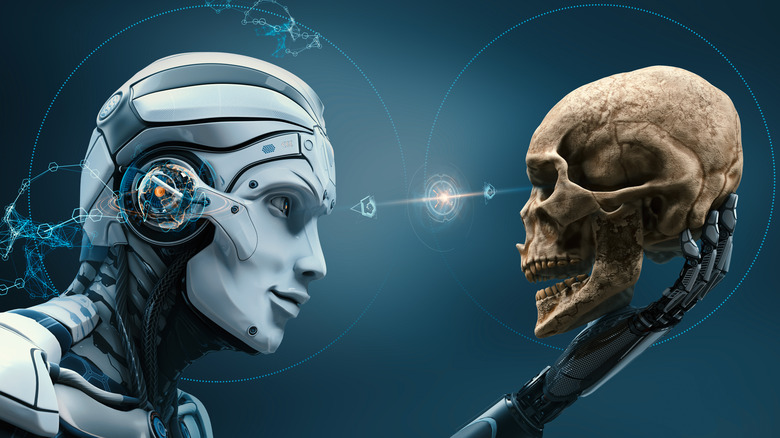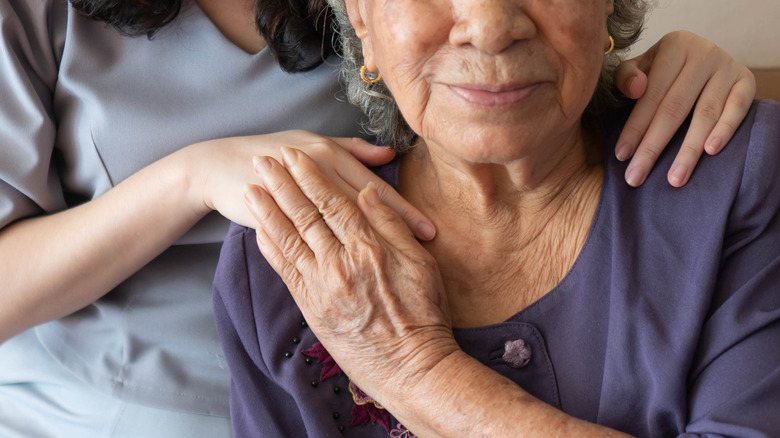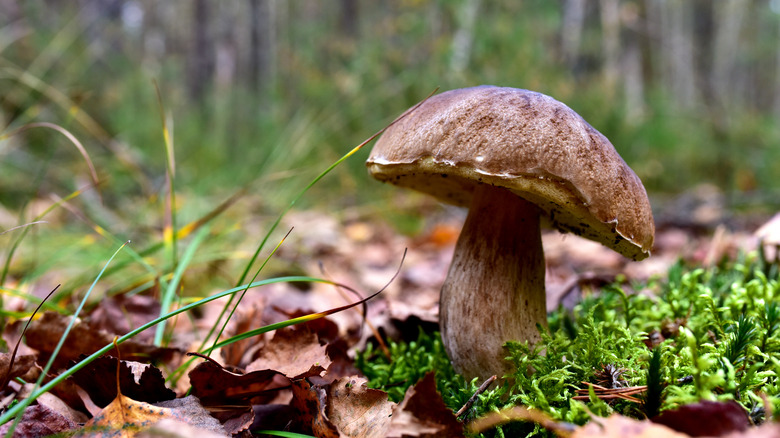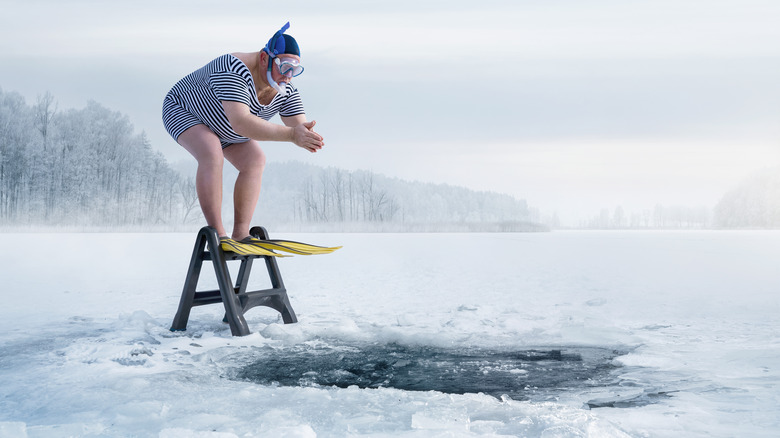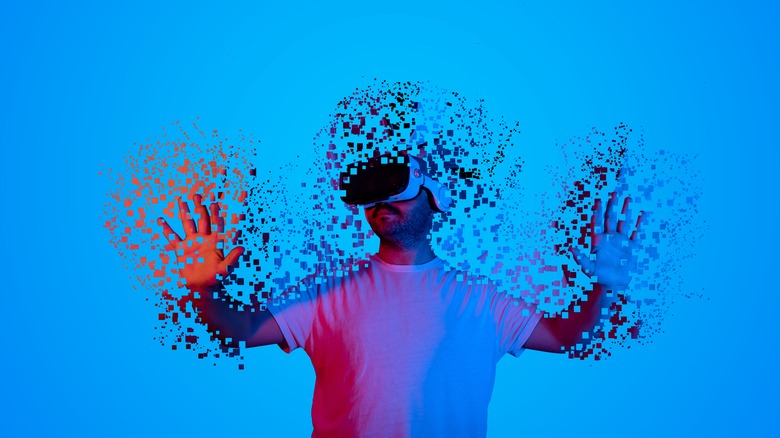How Death Will Change In The Future
The history of upright-walking creatures wandering this big, blue-green planet goes back a long time. The Smithsonian says that our very earliest ancestors go back to about six million years ago, while Homo sapiens started showing up around 300,000 years ago. A lot has changed since then, but the one thing that we've all had in common is the imminent prospect of death.
It's strange, then, that there's so much that's still unknown about it. According to the BBC, research into death suggests that many people are more afraid of losing loved ones than of dying themselves, and it kind of makes sense. It was Mary Shelley who wrote in "Frankenstein": "...the survivors are the greatest sufferers, and for them time is the only consolation."
Humans have an overwhelming need to be remembered, to make their mark on the world, and to make sure their existence meant something. That might be achieved by having kids, setting up a legacy, creating something that will be handed down through future generations, or just by being famous. But what about those future generations? What will death look like to them? The University of Cambridge suggests that even ancient Neanderthals had rituals they performed at the loss of their loved ones, and while those have evolved along with us, what's the next step of evolution?
Here's what will be most likely to kill
The Centers for Disease Control and Prevention keep track of mortality statistics for the country, and in 2020, they published updated statistics on what the most common causes of death in the U.S. were. At the top of the list were heart disease (taking 696,962 lives in 2020), cancer (602,350), COVID (350,831), and accidents (200,955). That was followed by two conditions that had almost the same numbers, killing around 150,000 people: Stroke and chronic lower respiratory diseases. Then, that was followed by Alzheimer's, diabetes, influenza, and pneumonia.
Campaigns like the Million Hearts initiative have been working to prevent things like heart attacks and stroke, so where does that leave the most common causes of death in the future? According to the CDC, they think it's going to look a little different.
In their report on the future of health and, in turn, death in the U.S., they say that the number of elderly adults is going to double by the year 2030. That means more people are going to be suffering from — and dying from — chronic and age-related causes. Cancer is projected to pass heart disease as the number one killer, while the number of deaths from hepatitis C is also expected to rise — by as much as three times. Alzheimer's is also on track to take one of the top spots, and it's expected that as the population ages, they're going to be facing these different dangers.
More people will be killed by extreme heat
In 2021, National Geographic reported on some dire statistics: Research published in Nature Climate Change had found that across six continents and 732 locations, a team of analysts had found that of all the heat-related deaths, 37% were related to climate change.
Heat is a sneaky killer, and at the time of the report, heat waves were already considered the deadliest natural disaster in the U.S. University of Hawaii climate scientist Camilo Mora wrote an eye-opening paper (via the American Heart Association) on just how many ways there are for heat to kill, and the answer is a surprising "27." Those ways include things like stress on the heart, cell damage that leads to a loss of brain function, kidney damage, and other fatal conditions, along with a massive organ failure that happens when the body redirects blood flow to the extremities in an attempt to shed heat.
Climate experts at the University of Chicago say that heat-related deaths will only continue to rise at a rate they estimate will be on par with the deaths seen from COVID-19. Particularly at risk are low-income areas where many families won't be able to afford things like protective infrastructure and air conditioning, and elder care facilities? They're going to be hard-hit in the coming decades.
That disparity is already being seen. That 37% number is just an average: In Ecuador, it's estimated that 77% of heat-related deaths were ultimately caused by climate change.
There's an app for everything — even death
Estate planning and will management used to be a huge undertaking that involved at least a lawyer or two. Now, The Guardian says that's changing with the emergence of apps designed to keep all your plans organized and up-to-date. There are apps like Everest, which allow users to plan their own funerals and leave those plans behind for loved ones to follow. There are also apps like SafeBeyond, and the emergence of others that fold things like funeral planning, estate arrangements, and living wills into one program. They even allow users to dictate what's going to happen to their online and social media presences, and some give people the option to create their own memorials.
Apps are only getting more and more in-depth. In 2022, CNET reported on an app called Bereev, which helps users make decisions about their own inevitable death by asking questions like, "How would you like to be remembered?" and "When do you feel most alive?"
Death tech, as it's called, is seen as a growing field — and it's one that's being driven by people who have seen what grief can do. The idea was summed up by Bereev founder Izumi Inoue, who explained the purpose of the apps: "I've ... seen ... the toll an unprepared death takes on the people left behind. ... When I go to heaven, the last thing I want is to put my loved ones through hell."
The campaigns to legalize euthanasia and assisted suicide
So, here's a question: Should a person be allowed to choose to die? It's a wildly controversial one that's bound to start some arguments — or, better yet, some conversations — but according to The Guardian, more and more people are believing that's a "Yes." University of Bristol professor of medical ethics and law Richard Huxtable says that the difference between euthanasia and assisted suicide is who takes the steps: In assisted suicide, it's the doctor who pushes the button, so to speak. In euthanasia (or assisted dying), it's the patient themselves.
The Netherlands, Switzerland, and Belgium were among the first countries to adopt legislation giving patients the right to choose to end their own lives, and they were joined by some U.S. states — including Oregon, Vermont, and Hawaii — along with states in Australia.
According to Medical News Today, statistics indicate there's a swing toward more people being in favor of having the option to choose. In 2013, people in 49 U.S. states were polled about their opinions, and 67% were against it. In 2017, that changed to 73% in favor of it. Other countries are also campaigning to legalize euthanasia and assisted suicide. The U.K., for example, has a movement spearheaded by groups like My Death, My Decision. They report that 90% of public opinion is in favor of reform to assisted dying laws, making it seem likely that in the future, it's an option that's going to become more widely available.
The maximum life span will increase ... but for how long?
Average life expectancy has been on the rise: The World Economic Forum says that the number of people hitting the big 100 was growing astronomically. In 1990, there were just 95,000 who made it to a century's worth of birthdays, and projections suggest that by 2050, that's going to rise to around 3.7 million. Will there ever be a time when 70 is the new 40? That's up for debate, but there's some compelling research out there.
Research from the University of Washington suggests (via Medical News Today) that by 2100, the human lifespan is going to hit 130. Is that the beginning? Maybe: One researcher, Aubrey de Grey, suggests that once we solve the problem of how to stop cellular decay, age-related health problems — and death — will be a thing of the past. He calls it "Methuselarity," but before anyone starts planning for immortality, there's a footnote here.
University of Brighton professor of Biogereontology Richard Faragher says (via The Conversation) that scientists have been trying to figure out the human body's absolute upper limits for a long time — and recently, studies suggest the oldest we're ever going to live to is 150. It was based on something called the dynamic organisms state indicator, which was basically a compilation of data on how the body's cells and organs decay with age. By 150? It seems unlikely we'll be able to fend off death any longer.
It's likely to get more eco-friendly
When NBC News did a deep dive into how humanity deals with the dead, they found something surprising: The 2.6 million people who die every year in the U.S. are actually having a measurable impact on climate change. Funeral processes — including the development of things like embalming and the use of caskets and vaults — were overhauled in the Victorian era amid the growing realization that just putting some bodies in the ground and throwing some dirt on them wasn't a great idea — especially considering the source of the area's drinking water might be right there, too. Now, it's suggested that the industry is going to get an overhaul again.
Suzanne Kelly is the author of "Greening Death: Reclaiming Burial Practices and Our Tie to the Earth." She estimates that by 2030, about 70% of deaths will end in cremations, and even those will be getting more eco-friendly with processes like alkaline hydrolysis, or water cremation. The end result is the same, but it uses about ⅛ of the energy, and doesn't release mercury like a traditional cremation.
There are other options being developed, too. The Urban Death Project is working on what's essentially a building where bodies would be allowed to decompose naturally into fertilizer, while the company Coeio is working on fungi-laden burial shrouds to also help with decomposition. As explained by The New York Times, greener, more eco-friendly burials in line with many ancient religious traditions are the way of the future.
Suspended animation might be able to save the once critically wounded
According to The New York Times, a person who has hypothermia set in can survive a loss of oxygen to the brain. It's followed, then, to explore whether or not taking a person who has catastrophic injuries, draining their blood, and replacing that blood with freezing saltwater could put the person in a state of suspended animation that would give doctors the time they needed to repair otherwise fatal wounds. The body temperature would drop below 50 Fahrenheit, and brain damage would take around an hour to occur, as opposed to the five minutes it would take were the person at a normal body temperature and metabolic rate.
The idea is that once the body was warmed again, their heart would start beating, and they would slowly regain consciousness — and fatal wounds would be not-so-fatal anymore. Testing the procedure, however, is a little bit of a moral and ethical grey area, as it's not exactly something that's easy to get consent to do. It's been done — a lot — in animals like pigs and dogs (and let's not talk about the ethical concerns here), with all signs pointing to the possibility it should be viable, in the future, to kill someone in order to save them.
According to the site of the University of Maryland's Dr. Samuel A. Tisherman, one of the surgeons at the forefront of the trauma research, they are still in the developmental phases of the program.
Some believe we'll cheat death altogether ... sort of
Ray Kurzweil is an MIT-educated engineer — and head of Google's engineering department — who believes that human bodies work pretty much the same as a machine, and once we have the blueprints that show just what makes the whole thing work, we'll be able to engineer them so they don't break. He likens the scientific expansion of human longevity to the progress of other kinds of technology, and says (via Prevention) that at some point, humanity will arrive at the Singularity. That, he says, is the point where we'll be able to augment our physical form and allow it to exist indefinitely.
Until then, ABC News says Kurzweil has been working on something else: Creating an avatar of his dead father that allows him to continue living ... in a way. The idea is to program the avatar with information from letters, photos, and documents to create a program that doesn't just know everything the person knew in life but can mimic everything about them. "That is a replica," Kurzweil says, "but I can actually make a strong case that it would be more like my father than my father would be, were he to live."
He explained the basis of his beliefs in the inevitable melding of tech and biology this way in 2013 (via NBC): "We're going to become increasingly non-biological, to the point where the biological part isn't that important anymore. Even if the biological part went away, it would make any difference."
Death cafes are becoming more popular, and conversation more open
A death café is a pop-up event organized around a blueprint created by John Underwood and his mother, psychotherapist Sue Barsky Reid. They wanted to create a space where people could gather to talk about any and all aspects of death — a conversation that isn't precisely taboo elsewhere, but let's be honest, it's almost taboo.
Underwood and Reid ran the first session out of their home in 2011, says eHospice. There's tea, there's cake, and there's a conversation about everything from dealing with grief to comforting the dying to dealing with family members who don't want to talk about the inevitable. Underwood explained to NPR: "When people sit down to talk about death, the pretense kind of falls away, and people talk very openly and authentically. And they say things in front of strangers which are really profound and beautiful."
When it comes to the future of death, death café events are only getting more popular — especially, says research from the University of Glasgow (via The Social Policy Blog), in a post-COVID world. The idea — which was inspired by a Swiss concept called café mortel — has since spread to more than 34 countries throughout Europe, Asia, Africa, and the Americas. Locations tend to tweak the idea for differences in cultures and concerns, but the idea is the same — and it's only going to become more widely accessible, all in the hopes of helping people come to terms with death.
People will still be able to talk to you ... sort of
In 2016, The Guardian reported on a start-up company called Eternime, which basically allowed users to store data about themselves in order to later have that data fed back into a chatbot, which would then — in theory — be able to mimic the person so well that loved ones could speak to it and feel like they were still talking to the person who had passed away. At the time, there were all kinds of questions, ranging from whether or not it was a healthy idea for grieving people, to if it was even possible.
Just three years later, Elon Musk's OpenAI firm developed something called GPT-2. It was an algorithm designed to do exactly what Eternime promised would be done: learn from source material to recreate believable communications. A form of it was released, and it became a site called Project December.
IFLScience says programmer Jason Rohrer turned it into a chatbot, and the end result was a program that could mimic the dead. The idea was that it might be used to talk to, say, Shakespeare, but when Joshua Barbeau tried feeding it information about his ex-girlfriend — who had died eight years prior — he found that the program provided him an eerily precise way to once again speak to the love he had lost (via the San Francisco Chronicle). Death might be permanent, but chatting just one more time? Priceless ... or unhealthy?
Cryonics is an increasingly studied field
Cryopreservation absolutely sounds like science fiction: Freeze the body — or part of it — until medicine advances to the point where it can cure whatever's wrong, then thaw it, fix it, and continue living happily ever after. That's the basics, and it's real. The BBC spoke with Max More, the head of one of the largest cryonics companies in the field. It's called Alcor, and he's not just the president and CEO, he's a member: More has signed up to have his brain frozen in a process called neuropreservation. It's a complicated process, in which a person has to be officially declared dead before Alcor's team can artificially reactivate blood flow, administer drugs to delay cell and organ decay, then prepare them for deep freeze.
More estimates that it'll be anywhere from 50 to 100 years before medical technology will catch up with the thawing and curing process that Alcor members are hoping for on the other end, but that hasn't stopped people from signing up to hopefully cheat death.
A few years after More's interview, the BBC reported that more facilities were opening around the world. But that brings up an interesting question: Thawing and reviving the physical body is one thing, but how will the human mind adapt to suddenly waking up in a world 100+ years in the future? What kind of support system would be in place? People might be able to cheat death, but how will they live?
The transhumanism debate may defeat death... for some
According to University of East London Ph.D. candidate Alexander Thomas, transhumanism refers to the desire to build a better human with the help of technology. Thomas says (via The Conversation) that it's based around something called NBIC: nanotechnology, biotechnology, information technology, and cognitive science.
Proponents suggest that in the future, health will be managed by nanobots patrolling the human body and looking for problems that can be solved before they even really start. Our biological bodies will interface with computer technology, and that might be the beginning. According to The Guardian, there are also suggestions that death could be pushed off to the point where humans were nearly immortal. How? Similar to the way we use things like dentures, hearing aids, glasses, and artificial limbs to improve quality of life, technology might just be able to replace things like aging and dying cells, or entire organs that would otherwise fail.
There's a surprising amount of stuff in the works, too, including full bodysuits designed to give medically compromised patients the strength to walk and move on their own, and artificial limbs outfitted with sensors that mimic the feeling of the original arm or leg. Transhumanists believe that these are all steps on the way to not just improving life, but warding off death ... for those who can afford it. It's that last bit that's led critics to wonder if this is leading toward more of a dystopian future than a utopian, death-free future.
Our pets might be living longer
Those who have cherished animal companions understand: What's the point of living forever if we just have to keep saying goodbye? There's good news here, too. While science, technology, and medicine have all been trying to come up with a way to keep death at bay longer for humans, they're working on the problem for our best friends, too. And in the future, they might just crack it.
In 2018, the MIT Technology Review reported on work being done at the Harvard Medical School. There, researchers were experimenting with reverse-aging dogs by "adding new DNA instructions to their bodies." It was based on earlier work that found mice appeared younger on a biological level after being given blood transfusions from younger mice. The start-up — called Rejuvenate — is also looking at prolonging life by getting rid of common breed-related problems like heart ailments, and reprogramming cells to take on their previous, youthful state.
They're not the only ones working on it. Discover Magazine reported that 2019 saw the launch of the Dog Aging Project, which was starting off by documenting precise ways that dogs age — along with the development and progression of breed-related illnesses — in the hopes of developing a drug that will keep our best friends happier and healthier for longer.
